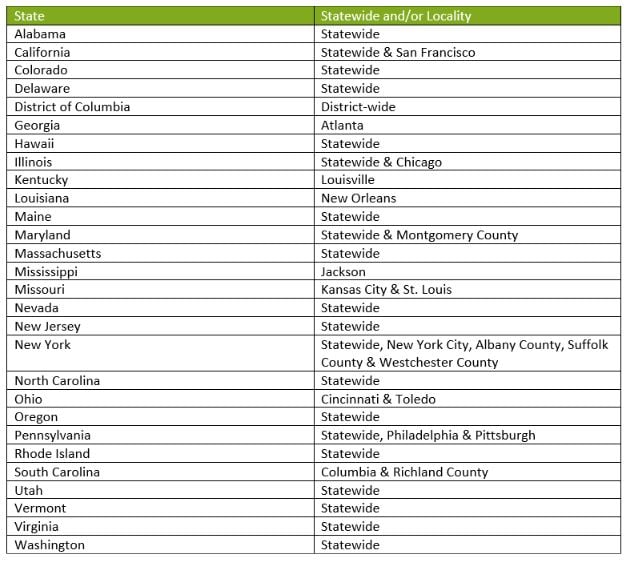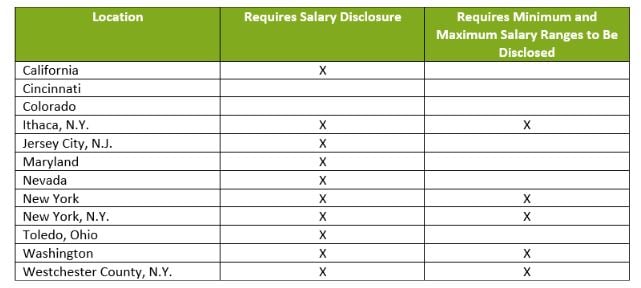In the past, most discussions about compensation were largely confined to the specific instances of either a job offer or the once-a-year “pay discussion” between manager and subordinate. Outside of these circumstances, the topic was generally not viewed as a subject for polite conversation.
In recent years, society has been pushing organizations to be more transparent when it comes to disclosure of salary information during the job application process or even in the workplace. According to a study conducted by Visier in 2022, 79% of employees want some form of pay transparency, 68% say they would switch employers for greater pay transparency, and 32% want total transparency.
The legal requirement for employer pay transparency was started by the state of Colorado in 2021. It was the first state to require employers to disclose salary ranges within all job advertisements. Since that time, seven states and six localities have passed legislation establishing pay transparency requirements for employers within their jurisdiction. Additionally, 21 states and 20 localities now have established statewide bans on requesting current salary or salary history from job applicants. This trend will likely grow in the future. (Please note this information is current as of February 2023. Please stay abreast of changes in the future. State pay transparency laws can be found on state department of labor websites. For localities, the best place to stay up to date would be on each city’s official website.)
The balance of this article outlines the most common pay transparency requirements adopted by various states/localities. Organizations would be well advised to carefully review this information to assess their readiness to comply with the types of information that are being made public.
Ban on Asking Job Applicant’s Current Salary
The first, and most widely established, pay transparency requirement is the ban on requesting salary history. Although all state/local laws have their unique provisions, salary history bans generally prohibit employers from asking job applicants and current employees questions regarding their salary history and/or current salary. Salary history bans have been put in place in hopes of reducing pay disparity and to encourage diversity among workforces.
Below is a list of the states/localities that have current salary history bans in place:

Disclosure of Pay Rate to Job Applicant
Counting Colorado as the first, seven states and six localities have now established unique laws surrounding employer pay transparency. The most common criteria included in these pay transparency laws is the requirement to disclose salary ranges in all job advertisements. This includes, but may not be limited to, disclosing the job’s target salary. Some jurisdictions require disclosure of the minimum and maximum salary range amounts or minimum and maximum hourly wage amounts.
Salary transparency and salary disclosures have been put in place to help foster higher levels of trust between employers and job seekers and to show organizational commitment to workplace pay equity. According to the Society for Human Resource Management, “91% of ‘employees’ who believe that their organization is transparent about how pay decisions are made also said that they trust their organization pays people equally for equal work regardless of gender, race and ethnicity”.
Below is a list of states/localities that have salary disclosure requirements along with the states/localities that have established salary minimum and maximum disclosure requirements:

Disclosure of Pay Rates to Employees
Another commonly included pay transparency requirement is disclosure of salary ranges to current employees. This can include a requirement to disclose salary ranges to employees up for promotion or transfer, and the requirement to disclose current salary ranges to employees who ask for the range for their current position. This internal reporting requirement is intended to encourage transparency at all levels of employment. This allows for employees to be aware of their position’s current salary expectations from the perspective of their current employer.
Below is a list of the states/localities that have established internal salary disclosure guidelines:

Of course, these disclosure requirements, regardless of the specific information involved, presume that your organization can readily supply the information and has a formalized program from which this information is secured. It would not be unreasonable to assume that as information is released to the public, there will be occasions where follow-up inquiries are made to provide more information and the process used to develop it. Now would be an excellent time to consider your organization’s preparedness for these disclosures or potential inquiries.
Written by Hannah Boyd. © 2023 BDO USA, LLP. All rights reserved. www.bdo.com



